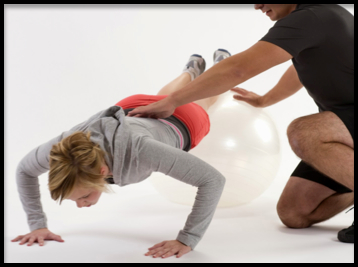by Daniel Lucas …
Are you getting the most out of every strength exercise? It’s an interesting question–one that we ask here at Nimble Fitness all the time. What we’ve discovered is that an exercise’s maximum benefit really depends on you, and where you are at with your training program.
 If you are new to exercise, for example, or have not been training for a while, then the first thing we’d look at is muscle activation of your postural stabilizers –the smaller muscle in and around your pelvis and lumber spine. How much weight you can lift is irrelevant if your posture is out of alignment. Positioning in a specific exercise can make a HUGE difference in whether it is effective, or ineffective, at sparking the result you are looking for. I can’t tell you how many times I’ve assessed someone who’s been training hard for a year, or attending an extremely challenging class like CrossFit, that cannot perform basic balance exercises properly. Remember, doing something extremely well for a few repetitions is much more effective than doing something crappy over and over again. Your chances for injury go way down, and your balance and strength go way up. Here are a few, and extremely significant, keys to success that you should strive to live by:
If you are new to exercise, for example, or have not been training for a while, then the first thing we’d look at is muscle activation of your postural stabilizers –the smaller muscle in and around your pelvis and lumber spine. How much weight you can lift is irrelevant if your posture is out of alignment. Positioning in a specific exercise can make a HUGE difference in whether it is effective, or ineffective, at sparking the result you are looking for. I can’t tell you how many times I’ve assessed someone who’s been training hard for a year, or attending an extremely challenging class like CrossFit, that cannot perform basic balance exercises properly. Remember, doing something extremely well for a few repetitions is much more effective than doing something crappy over and over again. Your chances for injury go way down, and your balance and strength go way up. Here are a few, and extremely significant, keys to success that you should strive to live by:
*Understand the goal of any movement or exercise program! You should know what a proper starting position is, your movement phase and your end goal. Know where your feet line up, where your hands go, what your hips are supposed to do, and at what speed. Understand that, in general, great form equals a stronger movement.
*If it feels awkward when you’re doing it then it’s probably something you need to avoid…you’re body’s not lying to you! Whether you are performing a heavy lift, or doing integrated strength movements with equipment like Kettle Bells, TRX or VIPR, if it feels weird, you’re probably in the wrong position. Something is not balanced and the body is in an incorrect muscle compensation pattern. Take the time to learn the proper mechanics of a move. You’ll quickly uncover any imbalances in your body that are preventing you from executing the move properly.
*Mastering Integrated Movements. Compound movements have a lot of moving parts, and a strong balance element, but deliver a big bang for your buck when training. This is because you are working so many muscles all at once. If there is a weak link in your muscular set up, you may feel as though your muscles are not all firing together or working together. Your sequencing may be off or you simply may not be ready for this particular movement. Break the movement down into small chunks and practice each section of the exercise to then pull it all together. For example, if the compound movement is a squat to press, master the squat and the shoulder press separately, then re-integrate the movement.
Most of the time a lack of true core strength and hip torso integration is the problem. Seek out a professional for assistance. I think that’s enough to chew on for the time being. One small change in form can make all the difference in an exercise being great or not good at all.
DL




